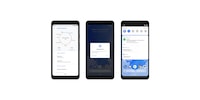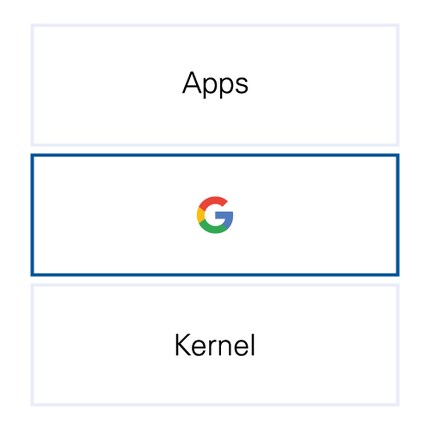
Background information
Android P: The new features at a glance
by Dominik Bärlocher

Starting in 2023, Ford brand cars will roll off the assembly line with Android Automotive. Google's proprietary software is the company's first foray into a market that will define the future of mobility. However, they'll have to avoid the pitfalls we all know from Android phones.
Google is making inroads into the automotive market. Future Ford vehicles will run on Android Automotive starting in 2023. Ford will therefore replace its own operating system Sync, which had still been lauded as possessing «new OTA updates» during the new Ford F-150 series launch. This consisted of an externally managed and cloud-based operating system that took quite a bit of inspiration from Google Maps Spotify.

This is a huge step forward for Ford. According to the media release, the group will no longer focus on developing software in future, instead adapting the software provided by Google for its own purposes.
I'm sure you remember Android Auto. You interface your phone with the car, your Ford Mustang's display discards the in-house software Sync and presents you with a Google interface.
That's not what we're talking about today. This article is all about Android Automotive.
The nomenclature can be confusing.
Android Automotive is a version of Android that doesn't run over Ford's Sync set, instead of the older software. It's not a mobile app of any kind, it's software that runs on your car. A kind of replacement to Sync, UConnect or whatever they're all called.
Since Android Automotive is a version of Android based on the same code as Android on your smartphone, it also integrates seamlessly with your Google account. And behind the scenes, there's still the same security updates, vulnerabilities, compatibility and developer tools. All in all, it's just like Android mobile with a few extra interfaces and a different look optimised for cars.
Android Automotive, just like Android, is open source and free. However, this statement is «slightly misleading» in everyday use, as demonstrated by the ongoing trade war raging between Huawei and Google. Yet aside from politics and the development of parallel software, here's what you need to know: Android without Google Services is only usable with great difficulty. Google Services are APIs located on Android that provide interfaces to Google Maps, your Google Account, and Google Pay, among others.

Google Services, however, are owned by Google, a U.S. company, and aren't open to just anyone. That gives the corporation a lot of power over an entire market. The same should hold true for Android Automotive. Any Chinese EV manufacturer that can make a car in a small Shenzhen garage can use Android Automotive, but not Google Services. Even if Chinese policy allowed it. You could theoretically add Android Automotive to any old machine, just like you can launch your own Android distribution.

To ensure that the further development of Android Automotive with Google Services progresses faster and closer to the end product, Google is looking for partners, as it did with Android mobile. One of these new partners is Ford. These partners have an influence on how the core software develops, receive pre-release versions of the software and help determine its development path. Volvo is also involved, by the way. The new, all-electric XC40 runs on Android.
Android Automotive is a fairly transparent push to conquer a new market. Cars are one of those things that move people emotionally and physically. They're a market where a lot of money is spent and a lot of data is collected. No wonder Google wants to get a piece of the action. Google is expecting billions in revenue and dependencies from the Ford and Volvo deals, with Polestar – a brand owned by Volvo with a rather active marketing team – having lower priority. And if all Ford cars run on Android, then all Ford cars will need to be updated as well.
Ford, meanwhile, promises less in-house word, which should lower software development costs. In addition, the blurb «powered by Android Automotive» is so naturally interesting on its own that I just wrote four A4 pages of text about it.

With the launch, an old Android problem has sprung back up. Updates. Historically, Android updates are delayed at best and ignored at worst. After all, every smartphone has different requirements. With an average smartphone lifetime of two years and a release cycle of at least one new flagship per year, updates just aren't worth the effort, both financially and in terms of time. Providing old hardware with new software if bigger and better hardware is just around the corner won't be your best choice.
In the past, critical security updates have also fallen by the wayside. Google did roll out Project Treble back in 2017, which allowed security updates to flow in behind the scenes without much code recompilation on the part of the phone maker. This has greatly accelerated updates in general, but the model-to-model update strategy has remained. A Samsung Galaxy S20 from last year still doesn't run on the same software version as the Samsung Galaxy S21 from this year, although nothing would stand in the way of this from a purely basic technological point of view.
Cars, however, have a much longer lifespan than a smartphone. An anecdotal example: a Land Rover built in 2011 with 190,000 kilometres built up still does a well enough job. Replacing it doesn't really make sense. A 2016 Mustang still speeds down the highway like nothing's wrong, and the 2020 Bullitt version is, roughly speaking, only visually different from the 2019 Mustang.

Nevertheless, the Mustang portfolio grows every year. Now and then a special edition is dropped, now and then one is added, such as the novel Mach-1. In this way, the release cycle of cars is pretty close to that of smartphones.
«...Google and Ford coming together establishes an innovation powerhouse truly able to deliver a superior experience for our customers and modernise our business,» says Jim Farley, Ford CEO. This indicates that Ford will make changes to Android Automotive in the release version. Just like Samsung does with its Galaxy Phones, which then leads to an update policy that only gives the latest software to the newest models.
Is Android Automotive facing the same fate as Android Mobile?
After all, Ford is also likely more interested in the 2021 Mustang with up-to-date software than in updating the Mustang already out for free. Free updates don't have a positive impact on the company's bottom line.
Following development, you've got the user experience, current or not. In the end you, a Mustang driver, operate the vehicle. Android Automotive offers much deeper integration into the vehicle than Android Auto ever could.
In short, you can interact directly with the car's systems, as your car is part of your Google ecosystem on the software side.
«Hey Google, turn on the AC» should work soon enough. As well as, at least theoretically, an authorisation system that could regulate access. So far, you need an ignition key to operate most cars. Keyless systems are on the rise, but still far from being the standard. Android Automotive has taken big steps towards granular permissions in the vehicle. The following scenario is plausible:
There's no official talk of «keyless» at Android Automotive yet, despite the fictitious but plausibly feasible suggestion I just made. Not yet, as I'm convinced that I am not the first with this idea or a comparable one. Navigation using Google Maps and Spotify integration, however, is notable.
Android Automotive, by the way, also works without an Android Phone. Apple users can use the software just like Google disciples. However, «Hey Siri» might only work in a limited way.
Journalist. Author. Hacker. A storyteller searching for boundaries, secrets and taboos – putting the world to paper. Not because I can but because I can’t not.